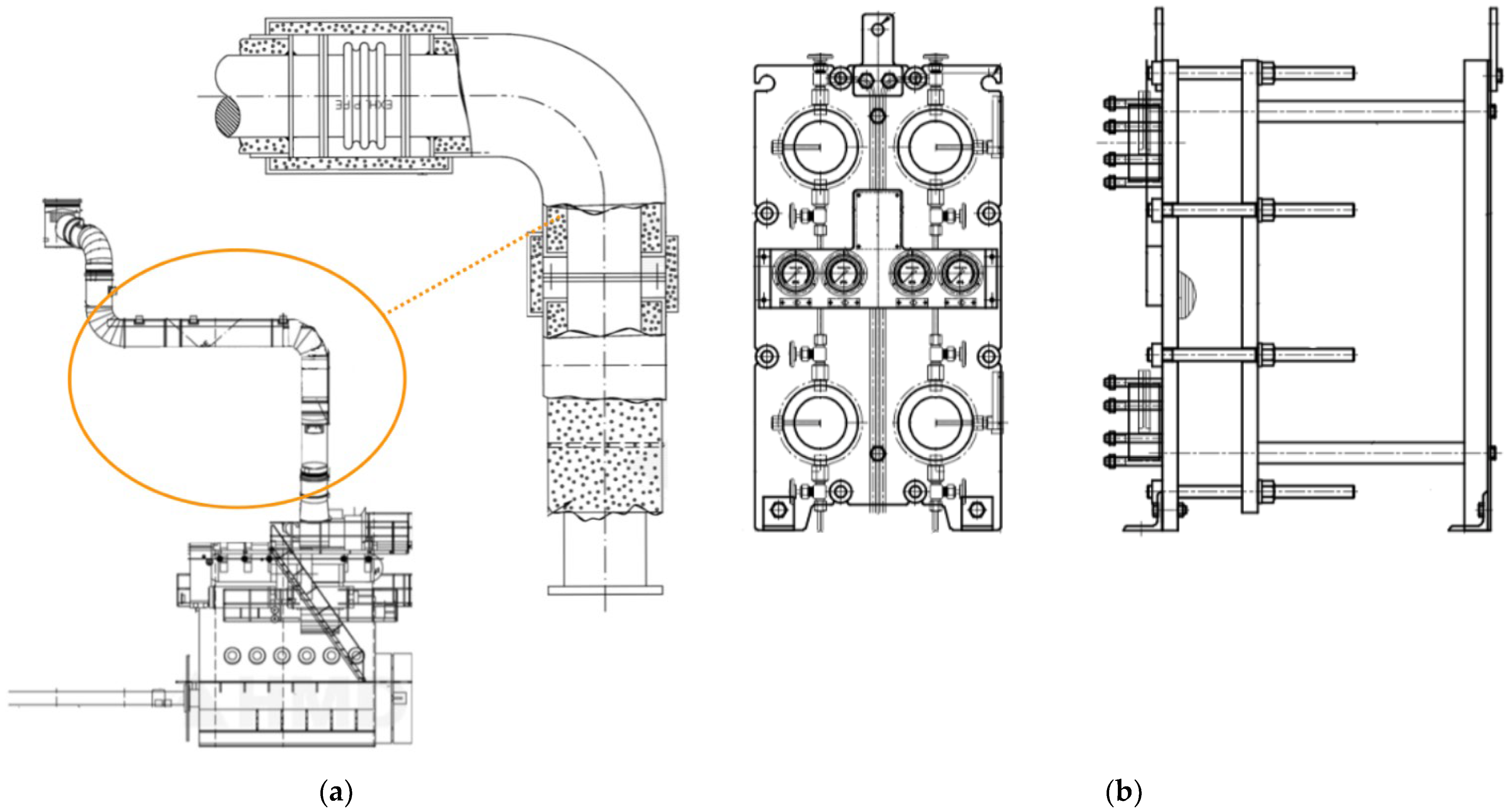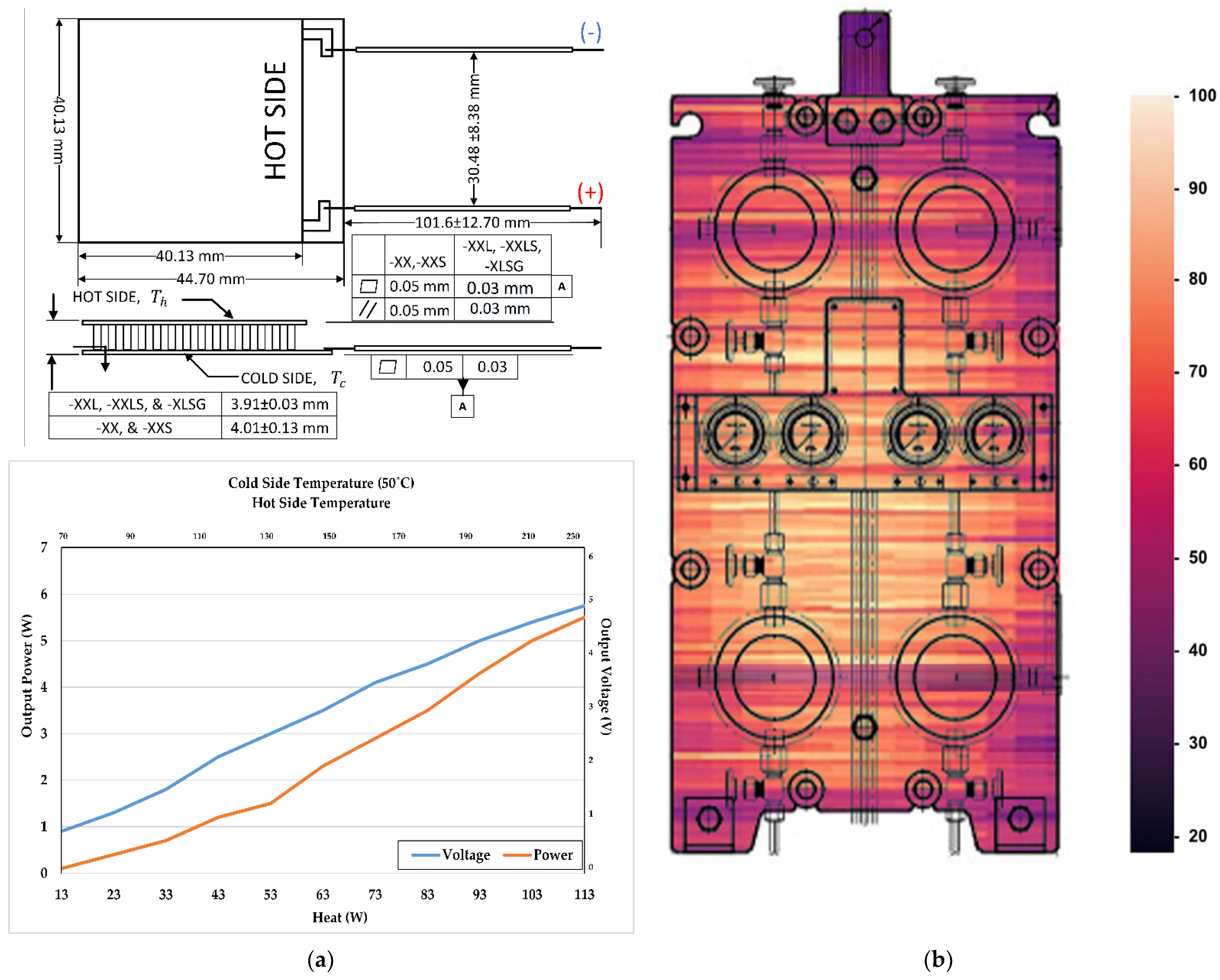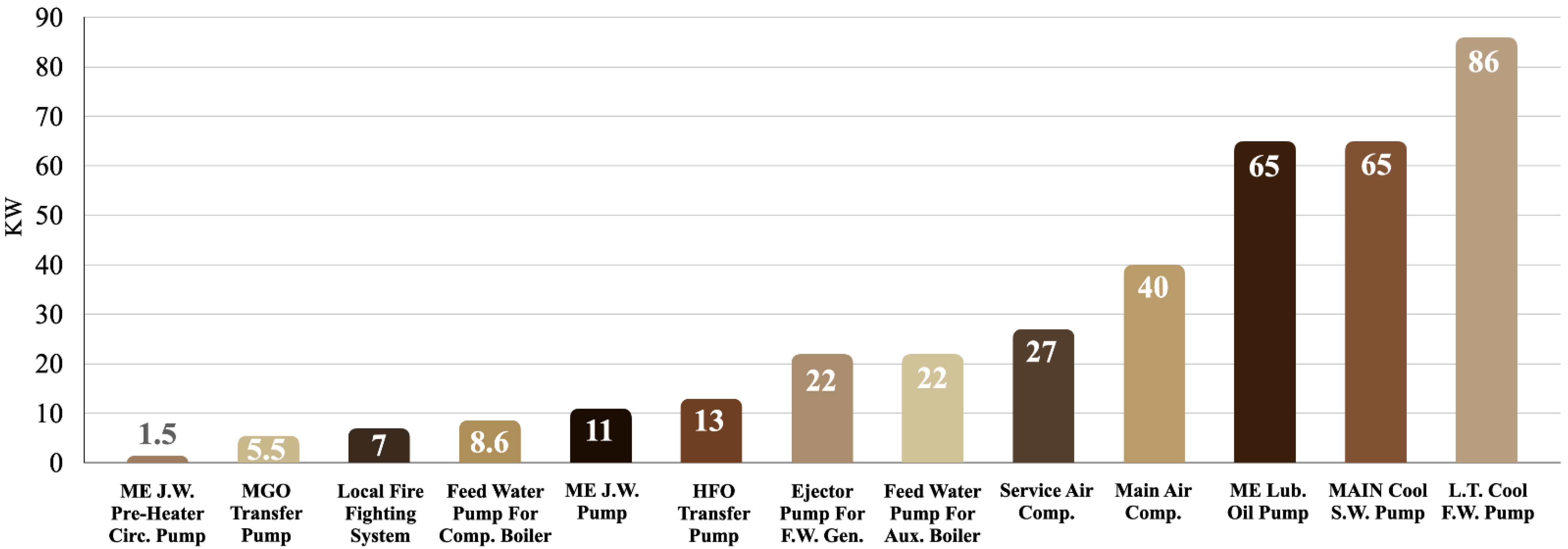Thermoelectric Generators as an Alternative Energy Source in Shipboard Microgrids
Abstract
:1. Introduction
- This paper presents a new approach to using thermoelectric generators as waste heat recovery systems on ships, and their potential usage areas to increase energy efficiency were evaluated;
- The emission inventory of the ship was determined using the actual data of the ship’s fuel consumption;
- The electrical energy and fuel consumption produced onboard in one year were examined;
- Effective zones with high-temperature differences were analyzed. The heatmaps were created using the real measurements of the ship’s main engine exhaust gas outlet line and jacket cooling water heat exchanger;
- The conditions of thermoelectric generators with high heat resistance were examined in the determined zones to provide optimum results.
2. Working Principles of Thermoelectric Materials
Estimation of Ship Emission Inventory
3. Methodology of the Study
4. Case Study and Results
Cost Analysis of the System
5. Conclusions
- It was determined that installing TEG systems on the ship used in the case study would result in a 2% gain in energy efficiency within a year;
- The obtained energy efficiency would help in the reduction of exhaust emissions as well as fuel savings, therefore contributing to the marine industry’s long-term sustainability and green future goals;
- TEG systems can feed the main cooling seawater pump for the ship cooling system, and the main and service air compressor responsible for supplying the necessary air for the systems onboard. By increasing the ship’s energy efficiency while cruising, fuel savings can be achieved;
- Local Fire Prevention System pumps could be kept available, independent of the ship’s energy grid, through the TEG system designed for the ME JCW heat. The simple structure and prolonged life of TEGs can make them easy to utilize throughout the ship’s commercial life.
Author Contributions
Funding
Institutional Review Board Statement
Informed Consent Statement
Data Availability Statement
Acknowledgments
Conflicts of Interest
References
- Lindstad, E.; Lagemann, B.; Rialland, A.; Gamlem, G.M.; Valland, A. Reduction of Maritime GHG Emissions and the Potential Role of E-Fuels. Transp. Res. Part D Transp. Environ. 2021, 101, 103075. [Google Scholar] [CrossRef]
- EIA Energy Information Administration. Choice Rev. Online 2019, 44, 44–3624. [CrossRef]
- Nuchturee, C.; Li, T.; Xia, H. Energy Efficiency of Integrated Electric Propulsion for Ships—A Review. Renew. Sustain. Energy Rev. 2020, 134, 110145. [Google Scholar] [CrossRef]
- MEPC. Annex 19: Resolution; MEPC, 2011; Volume 203, pp. 1–17. Available online: https://wwwcdn.imo.org/localresources/en/OurWork/Environment/Documents/Technical%20and%20Operational%20Measures/Resolution%20MEPC.203%2862%29.pdf (accessed on 9 May 2022).
- Ampah, J.D.; Yusuf, A.A.; Afrane, S.; Jin, C.; Liu, H. Reviewing Two Decades of Cleaner Alternative Marine Fuels: Towards IMO’s Decarbonization of the Maritime Transport Sector. J. Clean. Prod. 2021, 320, 128871. [Google Scholar] [CrossRef]
- IMO. MEPC.1/Circ.684; IMO: London, UK, 2009. [Google Scholar]
- IMO. Energy Efficiency Measures; IMO: London, UK, 2015; pp. 1–5. [Google Scholar]
- Rehmatulla, N.; Smith, T. Barriers to Energy Efficiency in Shipping: A Triangulated Approach to Investigate the Principal Agent Problem. Energy Policy 2015, 84, 44–57. [Google Scholar] [CrossRef] [Green Version]
- ABS. Ship Energy Efficiency Measures Advisory; ABS, 2014; p. 74. Available online: https://ww2.eagle.org/content/dam/eagle/advisories-and-debriefs/ABS_Energy_Efficiency_Advisory.pdf (accessed on 9 May 2022).
- Mallouppas, G.; Yfantis, E.A. Decarbonization in Shipping Industry: A Review of Research, Technology Development, and Innovation Proposals. J. Mar. Sci. Eng. 2021, 9, 415. [Google Scholar] [CrossRef]
- Bouman, E.A.; Lindstad, E.; Rialland, A.I.; Strømman, A.H. State-of-the-Art Technologies, Measures, and Potential for Reducing GHG Emissions from Shipping—A Review. Transp. Res. Part D Transp. Environ. 2017, 52, 408–421. [Google Scholar] [CrossRef]
- Olaniyi, E.O.; Atari, S.; Prause, G. Maritime Energy Contracting for Clean Shipping. Transp. Telecommun. 2018, 19, 31–44. [Google Scholar] [CrossRef] [Green Version]
- Karatsoli, M.; Nathanail, E. A Thorough Review of Big Data Sources and Sets Used in Transportation Research; Springer: Cham, Switzerland, 2018; Volume 36, pp. 540–550. ISBN 9783319744537. [Google Scholar]
- Diesel, M.A.N. Turbo, Thermo Efficiency System. 2014. Available online: https://mandieselturbo.com/docs/default-source/shopwaredocuments/efficiency-of-man-b-w-two-stroke-engines.pdf (accessed on 10 May 2022).
- Shu, G.; Liang, Y.; Wei, H.; Tian, H.; Zhao, J.; Liu, L. A Review of Waste Heat Recovery on Two-Stroke IC Engine Aboard Ships. Renew. Sustain. Energy Rev. 2013, 19, 385–401. [Google Scholar] [CrossRef]
- Lion, S.; Vlaskos, I.; Taccani, R. A Review of Emissions Reduction Technologies for Low and Medium Speed Marine Diesel Engines and Their Potential for Waste Heat Recovery. Energy Convers. Manag. 2020, 207, 112553. [Google Scholar] [CrossRef]
- Singh, D.V.; Pedersen, E. A Review of Waste Heat Recovery Technologies for Maritime Applications. Energy Convers. Manag. 2016, 111, 315–328. [Google Scholar] [CrossRef]
- Guo, X.; Zhang, H.; Wang, J.; Zhao, J.; Wang, F.; Miao, H.; Yuan, J.; Hou, S. A New Hybrid System Composed of High-Temperature Proton Exchange Fuel Cell and Two-Stage Thermoelectric Generator with Thomson Effect: Energy and Exergy Analyses. Energy 2020, 195, 117000. [Google Scholar] [CrossRef]
- Magwili, G.V.; Bulaong, M.L.D.; Macose, A.M.P.; Rodriguez, P.S.B. Thermos Design and Assembly for Conversion of Heat to Electrical Energy Based from the Principle of Seebeck Effect Using Thermoelectric Generator and Temperature Difference of Liquids. AIP Conf. Proc. 2018, 2045, 020057. [Google Scholar] [CrossRef]
- Solanki, S.S.; Chavan, A.B.; Tharwal, O.N.; Ghadi, T.M.; Sawant, S.P.; Bondre, S.S. Design and Implementation of Thermoelectric Energy Harvesting System with Thermoelectric Generator for Automobiles Battery Charging. In Proceedings of the International Conference on Inventive Communication and Computational Technologies (ICICCT), Coimbatore, India, 20–21 April 2018; pp. 131–134. [Google Scholar] [CrossRef]
- Wiriyasart, S.; Naphon, P. Thermal to Electrical Closed-Loop Thermoelectric Generator with Compact Heat Sink Modules. Int. J. Heat Mass Transf. 2021, 164, 120562. [Google Scholar] [CrossRef]
- Wang, J.; Cao, P.; Li, X.; Song, X.; Zhao, C.; Zhu, L. Experimental Study on the Influence of Peltier Effect on the Output Performance of Thermoelectric Generator and Deviation of Maximum Power Point. Energy Convers. Manag. 2019, 200, 112074. [Google Scholar] [CrossRef]
- Reverter, F. A Tutorial on Thermal Sensors in the 200th Anniversary of the Seebeck Effect. IEEE Sens. J. 2021, 21, 22122–22132. [Google Scholar] [CrossRef]
- Jouhara, H.; Żabnieńska-Góra, A.; Khordehgah, N.; Doraghi, Q.; Ahmad, L.; Norman, L.; Axcell, B.; Wrobel, L.; Dai, S. Thermoelectric Generator (TEG) Technologies and Applications. Int. J. Thermofluids 2021, 9, 100063. [Google Scholar] [CrossRef]
- Yusuf, A.; Bayhan, N.; Ibrahim, A.A.; Tiryaki, H.; Ballikaya, S. Geometric Optimization of Thermoelectric Generator Using Genetic Algorithm Considering Contact Resistance and Thomson Effect. Int. J. Energy Res. 2021, 45, 9382–9395. [Google Scholar] [CrossRef]
- Vostrikov, S.; Somov, A.; Gotovtsev, P.; Magno, M. Comprehensive Modelling Framework for a Low Temperature Gradient Thermoelectric Generator. Energy Convers. Manag. 2021, 247, 114721. [Google Scholar] [CrossRef]
- Li, X.; Wang, J.; Meng, Q.; Yu, D.; Huang, Z. The Influence of Peltier Effect on the Exergy of Thermoelectric Cooler-Thermoelectric Generator System and Performance Improvement of System. SSRN Electron. J. 2021, 3918962. [Google Scholar] [CrossRef]
- Zaferani, S.H.; Jafarian, M.; Vashaee, D.; Ghomashchi, R. Thermal Management Systems and Waste Heat Recycling by Thermoelectric Generators—An Overview. Energies 2021, 14, 5646. [Google Scholar] [CrossRef]
- Zoui, M.A.; Bentouba, S.; Stocholm, J.G.; Bourouis, M. A Review on Thermoelectric Generators: Progress and Applications. Energies 2020, 13, 3606. [Google Scholar] [CrossRef]
- Aridi, R.; Faraj, J.; Ali, S.; Lemenand, T.; Khaled, M. Thermoelectric Power Generators: State-of-the-Art, Heat Recovery Method, and Challenges. Electricity 2021, 2, 359–386. [Google Scholar] [CrossRef]
- Araiz, M.; Casi, Á.; Catalán, L.; Aranguren, P.; Astrain, D. Thermoelectric Generator with Passive Biphasic Thermosyphon Heat Exchanger for Waste Heat Recovery: Design and Experimentation. Energies 2021, 14, 5815. [Google Scholar] [CrossRef]
- Jia, X.; Fan, S.; Zhang, Z.; Wang, H. Performance Assessment of Thermoelectric Generators with Application on Aerodynamic Heat Recovery. Micromachines 2021, 12, 1399. [Google Scholar] [CrossRef]
- Albatati, F.; Attar, A. Analytical and Experimental Study of Thermoelectric Generator (Teg) System for Automotive Exhaust Waste Heat Recovery. Energies 2021, 14, 204. [Google Scholar] [CrossRef]
- Von Lukowicz, M.; Schmiel, T.; Rosenfeld, M.; Heisig, J.; Tajmar, M. Characterisation of TEGs Under Extreme Environments and Integration Efforts Onto Satellites. J. Electron. Mater. 2015, 44, 362–370. [Google Scholar] [CrossRef]
- Von Lukowicz, M.; Abbe, E.; Schmiel, T.; Tajmar, M. Thermoelectric Generators on Satellites—An Approach for Waste Heat Recovery in Space. Energies 2016, 9, 541. [Google Scholar] [CrossRef]
- Moreno, R.J.; Pollman, A.; Grbovic, D. Harvesting Waste Thermal Energy from Military Systems. Am. Soc. Mech. Eng. Power Div. Power 2018, 2, V002T12A012. [Google Scholar] [CrossRef]
- Dai, D.; Zhou, Y.; Liu, J. Liquid Metal Based Thermoelectric Generation System for Waste Heat Recovery. Renew. Energy 2011, 36, 3530–3536. [Google Scholar] [CrossRef]
- Meng, F.; Chen, L.; Xie, Z.; Ge, Y. Thermoelectric Generator with Air-Cooling Heat Recovery Device from Wastewater. Therm. Sci. Eng. Prog. 2017, 4, 106–112. [Google Scholar] [CrossRef]
- Chen, L.G.; Meng, F.K.; Sun, F.R. Thermodynamic Analyses and Optimization for Thermoelectric Devices: The State of the Arts. Sci. Chin. Technol. Sci. 2016, 59, 442–455. [Google Scholar] [CrossRef]
- Qiu, K.; Hayden, A.C.S. Development of a Thermoelectric Self-Powered Residential Heating System. J. Power Sources 2008, 180, 884–889. [Google Scholar] [CrossRef]
- Fernández-Yáñez, P.; Romero, V.; Armas, O.; Cerretti, G. Thermal Management of Thermoelectric Generators for Waste Energy Recovery. Appl. Therm. Eng. 2021, 196, 117291. [Google Scholar] [CrossRef]
- Ezgi, C.; Özbalta, N.; Girgin, I. Thermohydraulic and Thermoeconomic Performance of a Marine Heat Exchanger on a Naval Surface Ship. Appl. Therm. Eng. 2014, 64, 413–421. [Google Scholar] [CrossRef]
- Sifi, I.; Kaid, N.; Ameur, H.; Inc, M.; Baleanu, D.; Menni, Y.; Lorenzini, G. Comparison between the Thermoelectric Properties of New Materials: The Alloy of Iron, Vanadium, Tungsten, and Aluminum (Fe2V0.8W0.2Al) against an Oxide Such as NaCO2O4. Optik 2021, 247, 168035. [Google Scholar] [CrossRef]
- Tan, Q.; Chen, G.; Sun, Y.; Duan, B.; Li, G.; Zhai, P. Performance of Annular Thermoelectric Couples by Simultaneously Considering Interface Layers and Boundary Conditions. Appl. Therm. Eng. 2020, 174, 115301. [Google Scholar] [CrossRef]
- Aravind, B.; Hiranandani, K.; Kumar, S. Development of an Ultra-High Capacity Hydrocarbon Fuel Based Micro Thermoelectric Power Generator. Energy 2020, 206, 118099. [Google Scholar] [CrossRef]
- EMEP/EEA EMEP/EEA. Air Pollutant Emission Inventory Guidebook 2019. J. Chem. Inf. Model. 2019, 53, 1689–1699. [Google Scholar]
- IMO. Fourth IMO GHG Study 2020; International Maritime Organization: London, UK, 2020. [Google Scholar]
- Pavlenko, N.; Comer, B.; Zhou, Y.; Clark, N.; Rutherford, D. The Climate Implications of Using LNG as a Marine Fuel. ICCT Work. Pap. 2020-02. 2020. Available online: https://Theicct.Org/Sites/Default/Files/Publications/Climate_implications_LNG_marinefuel_01282020.Pdf (accessed on 12 May 2022).
- Marlow Industries. Technical Data Sheet for TG12-8 Single-Stage Thermoelectric Generator; Marlow Industries Europ: Weiterstadt, Germany, 2021; pp. 1–2. [Google Scholar]
- TG12-6-01L-II-VI Marlow Stock Available. The Distributor Micro-Semiconductor.Com Offer the Best Price with New Original Products. Available online: https://www.micro-semiconductor.com/products/Luminary-Micro-Texas-Instruments/SN74AHC125N (accessed on 12 May 2022).
- Inverter, Solar Inverter, Home Power Inverter. Available online: https://www.inverter.com/ (accessed on 12 May 2022).
- Väisänen, J.; Kosonen, A.; Ahola, J.; Sallinen, T.; Hannula, T. Optimal Sizing Ratio of a Solar PV Inverter for Minimizing the Levelized Cost of Electricity in Finnish Irradiation Conditions. Sol. Energy 2019, 185, 350–362. [Google Scholar] [CrossRef]
- Celik, A.N.T.; Muneer, P.C. Optimal Sizing and Life Cycle Assessment of Residential Photovoltaic Energy Systems with Battery Storage. Prog. Photovolt. Res. Appl. 2015, 20, 6–11. [Google Scholar] [CrossRef]






| Fuel Type | (kg/tonne) | (kg/tonne) | PM10 (kg/tonne) | PM2.5 (kg/tonne) | (kg/tonne) |
|---|---|---|---|---|---|
| HFO | 75.90 | 50.83 | 7.55 | 6.94 | 3.114 |
| MGO | 56.71 | 1.37 | 0.90 | 0.83 | 3.206 |
| Specifications | |
|---|---|
| Type of the ship | Tanker |
| Built year | 2017 |
| Length O. A. (m) | 183.0 |
| Breadth (m) | 32.20 |
| Deadweight (Tonnes) | 49,900 |
| Main engine type | Slow speed |
| Main engine power (kW) | 8502 |
| Aux. engine power (kW) | 900 × 3 |
| Exh. Gas quantity (kg/h) | 58,900 |
| Exh. Gas Avg. Temp. (°C) | 324 |
| LOAD (%) | 25 | 50 | 75 | 85 | 100 |
| SFOC | 207 | 193 | 189 | 189 | 192 |
| Fuel Type | ME (tonne/yr) | AE (tonne/yr) | ME ($/yr) | AE ($/yr) |
|---|---|---|---|---|
| MGO | 841.59 | 171.71 | $610,994 | $124,660 |
| VLSFO | 3120.11 | 420.37 | $1,912,626 | $257,685 |
| Emission | ME (kg/tonne) | AE (kg/tonne) | Total (kg/tonne) |
|---|---|---|---|
| CO2 | 12,643.79 | 1890.46 | 14,534.25 |
| NOX | 236.64 | 35.19 | 271.83 |
| SOX | 36.29 | 4.97 | 41.26 |
| PM10 | 7.72 | 1.09 | 8.81 |
| PM2.5 | 7.10 | 1.01 | 8.11 |
| Item Name | Quantity | Unit Cost | Total Cost | Unit Specifications |
|---|---|---|---|---|
| TEG [49] | 15,086 | 8.911 | 134,431 | [50] |
| Inverter [51] | 3 | 4312.47 | 12,938 | Input Voltage = 820 VDC, Output Voltage = 440 VAC, Output Power = 30 kW |
| Installation [52] | 1 | - | 22,100 | - |
| Maintenance [53] | Per year | 1473.8/yr | 1473.8/yr | - |
Publisher’s Note: MDPI stays neutral with regard to jurisdictional claims in published maps and institutional affiliations. |
© 2022 by the authors. Licensee MDPI, Basel, Switzerland. This article is an open access article distributed under the terms and conditions of the Creative Commons Attribution (CC BY) license (https://creativecommons.org/licenses/by/4.0/).
Share and Cite
Uyanık, T.; Ejder, E.; Arslanoğlu, Y.; Yalman, Y.; Terriche, Y.; Su, C.-L.; Guerrero, J.M. Thermoelectric Generators as an Alternative Energy Source in Shipboard Microgrids. Energies 2022, 15, 4248. https://doi.org/10.3390/en15124248
Uyanık T, Ejder E, Arslanoğlu Y, Yalman Y, Terriche Y, Su C-L, Guerrero JM. Thermoelectric Generators as an Alternative Energy Source in Shipboard Microgrids. Energies. 2022; 15(12):4248. https://doi.org/10.3390/en15124248
Chicago/Turabian StyleUyanık, Tayfun, Emir Ejder, Yasin Arslanoğlu, Yunus Yalman, Yacine Terriche, Chun-Lien Su, and Josep M. Guerrero. 2022. "Thermoelectric Generators as an Alternative Energy Source in Shipboard Microgrids" Energies 15, no. 12: 4248. https://doi.org/10.3390/en15124248
APA StyleUyanık, T., Ejder, E., Arslanoğlu, Y., Yalman, Y., Terriche, Y., Su, C.-L., & Guerrero, J. M. (2022). Thermoelectric Generators as an Alternative Energy Source in Shipboard Microgrids. Energies, 15(12), 4248. https://doi.org/10.3390/en15124248








